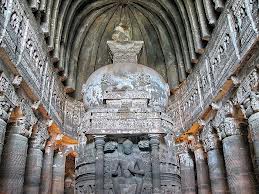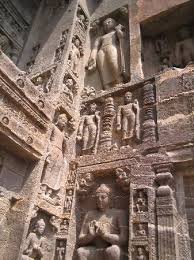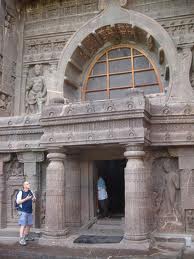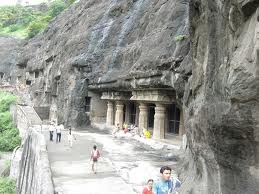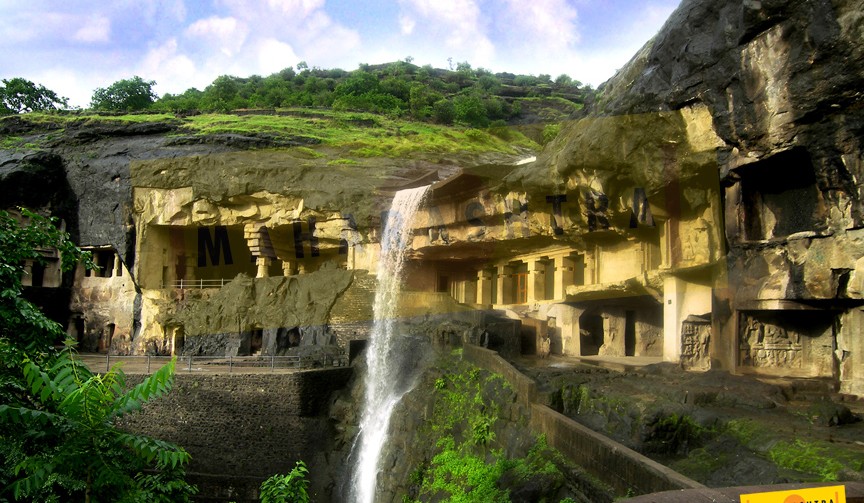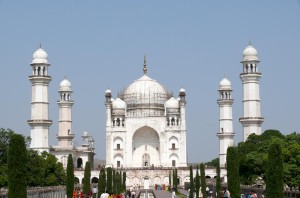India /Maharashtra /Aurangabad /Aurangabad
Sight Address : Ajanta Caves is near Jalgaon (61 kms), and from Aurangabad, India, The Ajanta Caves is 107 km. Edit
Detail InformationEdit
The Ajanta Caves situated about 107 kilo meters from the Aurangabad city and just 61 kms from Jalgaon; the rock-cut caves of Ajanta nestle in a panoramic gap, in the form of a massive horse shoe. Among the finest examples of some of the earliest (from the second century BCE) Buddhist architecture, caves-paintings and sculptures, these caves comprise Chaitya Halls, or shrines, dedicated to Lord Buddha and Viharas, or monasteries, used by Buddhist monks for meditation and the study of Buddhist teachings. Since 1983, the Ajanta Caves have been a UNESCO World Heritage Site. Way back in1819, a party of British army officers on a tiger hunt in the forest of western Deccan, suddenly spotted their prey, on the far side of a loop in the Waghora River, high up on the horseshoe- shaped rock face; the hunting party saw the tiger, silhouetted against the fixed front of a cave. There are 29 caves Ajanta (as officially numbered by the Archaeological Survey of India), of which 9, 10, 19, 26 and 29 are chaitya-grihas and the rest are monasteries. These caves were discovered in AD 1819. All paintings show heavy religious influence and centre around Buddha, Bodhisattvas, incidents from the life of Buddha and the Jatakas.The paintings are executed on a ground of mud-plaster in the tempera technique. The paintings on the walls, illustrate the events in the life of Prince Gautama Buddha, the founder of Buddhism and in the more popular Jatakas stories pertaining to Buddha’s previous incarnation. Incidentally they contain the scenes of semi-mythological history, the royal court and popular life of the ancient times, as told in romances and plays. Some pictures recall the Greek and Roman compositions and proportions, few late resemble to Chinese manners to some extent. But majority belongs to a phase, which is purely Indian, as they are found nowhere else.
HistoryEdit
Ajanta was a kind of college monastery, like other ancient Buddhist monasteries, with a large emphasis on teaching, and divided into several different colleges for living and for some of the education, under a central direction. The layout of the site reflects this organizational structure, with most of the caves only connected via the exterior. The seventh-century travelling scholar Xuanzang informs us that Dinnaga, the celebrated Buddhist philosopher and controversialist, author of well-known books on logic, lived there in the 5th century. In its prime the settlement must have accommodated several hundred teachers and pupils. Many monks who had finished their first training may have used Ajanta as a base to return to during the monsoon season from an itinerant lifestyle. Like other ancient Buddhist monasteries, The caves are generally agreed to have been made in two distinct periods, separated by several centuries.
Must SeeEdit
Must see
Visiting TimeEdit
9am until sunset (around 5.30 p.m.).
Closed OnEdit
Tuesday
Best Season to VisitEdit
October to March.
Best Time To VisitEdit
Morning, Afternoon.
Time Required for SightseeingEdit
N.A.
Ticket Required : Yes Edit
Individual National Adult Rs. : Rs. 10
Kids Rs. : N.A.
Individual Foreigner Adult Rs. : Rs. 250
Kids Rs. : N.A.
Still Photo Camera Rs. : N.A.
Video Camera Rs. : Rs. 25
Guide Required : No Edit
Approximate cost: N.A.
Dress Code (If Any) : No Edit
Dress Require: N.A.
Restaurants NearbyAdd / Edit
- N.A. ; N.A. ; Ph/M – N.A. ; Food Serve – N.A.
How to ReachEdit
Taxi : The taxi stand is next to the MSRTC bus stand; share jeeps also depart from here for destinations around Aurangabad. Expect to pay Rs.600 for a full-day tour in a rickshaw, or Rs.900 in a taxi.
Bus : MSRTC also operates an intra-city bus service called ‘Aurangabad City Bus’ which connects different parts of the city together along with connecting the city to its nearby suburbs. The bus system is even more complicated for those who do not speak the local Marathi language, which equates to just about every foreign visitor here. Your best bet is to ask someone in your hotel before you leave what bus you would need to take to get to your planned destination. If you can track down this bus and get on as well as let the driver know your destination, then buses here are very convenient and inexpensive at just a couple of rupees per trip.
Train : Aurangabad’s train station (Station Rd East) is not on a main line, but two heavily-booked trains, the Tapovan Express (2nd class/chair ₹102/338, 7½ hours, 2.35pm) and the Janshatabdi Express (2nd class/chair ₹127/420, 6½ hours, 6am) run direct to/from Mumbai. For Hyderabad (Secunderabad), take the Devagiri Express (sleeper/2AC ₹224/822, 10 hours,4.05am). To reach northern or eastern India,take a bus to Jalgaon and board a train there.
Air : Aurangabad Airport, popularly known as the Chikalthana airport is the main domestic airport here. It is situated 10 km east of the city. Both Indian Airlines and Jet Airways have a daily flight to Mumbai (Bombay). The airport is 10km east of town. En route are the offices of Indian Airlines (2485241; Jalna Rd) and Jet Airways (2441392; Jalna Rd) There are daily flights to Delhi, with a stopover in Mumbai. Fares start from around Rs.1500. Taxis are available to and from airport.
Others : N.A.
Things to CarryEdit
Bring a torch with you to the Ellora caves as many of them are quite dark and lighting is poor.
Safety / WarningEdit
Eat safely (no street stall foods, no buffets, eat fruits/veg that can be peeled and well-cooked food, drink sealed bottled water). Use sun screen/mosquito repellent, put a hat and sunglasses on your child.Wear closed shoes, not sandals.
HelplineEdit
Ambulance 108
Fire 101
Police Stations 100
Railway Enquiry 131
Tourist Information Office 0240-2331217
